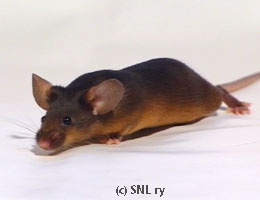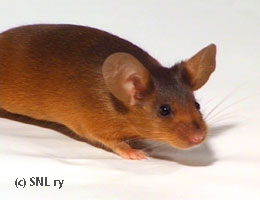Varieties
Shaded and Pointed
Sable (sa)
Ay/at B/* C/* D/* P/* U/*
"Eyes black. The top colour shall be a rich dark brown, as dark as possible, from nose to tail root. The belly colour to be as rich a golden tan as possible and the shading from top to belly to be gradual and even with no line of demarcation nor any blotch, patch, ticking or streakiness. There should be no white hairs whatsoever."
Breeding information below the pictures.
Breeding Sables
Sable is one of my all time favourite varieties and I've bred them since 1995. It took time to get from mice that were almost-recognizable-as-sables that lost their shadings pretty much completely with age and didn't get anything (for a good reason) in shows, to mice that were actually winning. I am, of course, talking about my own mousery. Sables had been bred and shown in Finland before I started my own line, which I started from scratch (red x black tan). However, sable tends to be one of those varieties where there's pretty much only one mousery working on it at any one time. Not that this isn't the case with a larger number of varities. After all, there's a huge number of mouse varieties out there and only a limited number of breeders.
Enough with the opening comments and on with the subject at hand!
Genetics
The standard says:
"Eyes black. The top colour shall be a rich dark brown, as dark as possible, from nose to tail root. The belly colour to be as rich a golden tan as possible and the shading from top to belly to be gradual and even with no line of demarcation nor any blotch, patch, ticking or streakiness. There should be no white hairs whatsoever.""
The genotype of a sable is: Ay/at B/* C/* D/* P/* U
Opening up the genetic code:
Ay/at means, that the mouse has dominant lethal yellow and black-and-tan in the a-locus. The first being wholly dominant, being the upmost dominant of the locus. The latter is the top dominant of the a-locus recessives available to mouse fanciers and has interesting qualities: it is dominant over ”big A” on the belly. That is, the mouse has a tan belly, even if it had A, which dominates the back colour (which gives you an agouti tan). at isn't a must, but works.
B/* tells you that when it comes to black/brown pigment, the mouse is black. It doesn't have cordovan or brown dilutions.
C/* means the mouse has full colour in c-locus: it doesn't have recessives (although can carry such).
D/* tells the mouse doesn't have blue dilution and is black in the black/blue locus d.
P/* gives the variety black eyes, not pink.
U is what gives sable it's distinctive shadings: the umbrous determinant.
Furthermore, the colouration of a sable is determined by modifiers. Modifiers are genes affecting the effect of another gene. The influence of a single modifier is relatively small, but the effects of them in groups "pile up". Most of the work mouse fanciers do with their selective breeding is piling up the right modifiers on the right animals
In More Practical Terms
As sable is heterozygous in the a-locus (meaning it has two different alleles), it doesn't breed true. This means you'll always get other varieties when breeding two sables together. Usually black tan. In practice, there are more possible outcomes, as Ay/a and even Ay/A can look exactly like an Ay/at sable, as long as they have U. Some Ay/A can be told apart by typical banded hair colouring of agoutis on back hairs. With Ay/a and Ay/A sables, you can get agouti, agouti tan and black (and b-locus dilutes of such). These more variable litters are usually occurring when you're still close to original red x black tan -crosses, as the genetic background of a red can be quite variable when it comes to a and b loci.
As with other Ay varieties, sable has tendency of gaining weight and can suffer from lower fertility because of that. Litter size in sable x sable crosses is smaller than usual, as Ay is lethal in homozygous form. Ay/ Ay babies die in utero around day 6. A fat sable doe may have smaller than usual litters even when mated with a non-sable buck, but that is because of the overall effect of obesity on fertility.Oh My, This Isn't an Easy Colour!
The problematic points in sable colouring can be divided into those relating with the back colour and shading, and those relating with redness. Dividing further from here:
- Back colour & shadings:
- the colouring of them
- evenness
- spread: from nose tip to tail root
- how well they "keep"
- Redness:
- right shade of the colour
Back colour and shadings are the distinguishing aspects of a sable. They are also the hardest to get right. The breeder should strive for getting all the different requirements of a good sable into a mouse and for having them stay good.
The back should be as dark, rich sepia as possible (compaare with mock black/mock chocolate a/a cch/cch sepia). Here we're at the first aspect one needs to take into account in selectively breeding sables, as getting the right darkness needs attention. The back can easily stay and/or go light, even one resembling a chocolate sable, especially after initial red x black tan crosses.
Back colouring should extend from nose tip to the tail root. That is to say, there shouldn't be any red on them. The problem of "spead" tends to intensify as the mouse ages, with each molt diminishing the spread of the back colour and shadings. If you have to make a choice between a mouse with a light back and one with light nose / tail root – pick the former, as it is easier to get the back darker, than to eradicate the problems of spread.
Both the back colour and the shadings should be even, with the shadings being also gradual. As with other varieties belonging to the same colour group (shaded and pointed), sable is prone to streaks and unevenness caused by molting. It is better to try to select against this tendency, even if it sometimes feels like mission impossible.
The shadings should extend low enough on the mouse's sides, but at the same time it shouldn't give an impression of being a black tan with tan rising a tad high. Even with darkness being highly desirable, you must not sacrifice proper shading to get it!
Getting the shadings (and back colour) to stay can cause headaches in the early stages of breeding sables and it is also something that's easily lost when crossing back to red (which are done occasionally to get the redness better). Sables that look quite nice, even showable, can turn into a sooty red with a darker "cap" with molts.
The key thing in fine tuning back colour and shadings is getting the modifiers right and having good nerves.
When it comes to redness, it isn't usually that problematic to get good enough colour. Getting the colour smashing takes work. You should always try to remember to keep a good balance, so you won't end up with a sable of great red belly, but with quickly lost shadings.
Starting From Scratch
If there aren't any sables available and you need to start from scratch with the variety, the best first cross is red to a good black tan. This combination brings together the basic elements of sable (always depending on the tricks of genetics and heredity): Ay and U. The first is what you get from the red, the latter from the black tan. U gives depth to backs of black tan mice, without affecting negatively the tan belly.
You don't need the best of reds for sable project. If you can, pick a red with a good depth to redness, but ridden with sootiness. What gives headaches to those trying to breed red, is useful to a sable breeder. While sootiness isn't necessarily caused by umbrous determinants, it most likely comes from modifiers affecting shadings. The black tan mouse should have a rich, deep tan belly and a good black back. However, you need not worry about tan ticking on the sides, or throat spots.
For further selective breeding, suitable combinations are sable x black tan, sable x sable and when need be, sable x red and red (with sable background) x black tan. It pays to keep all three varieties in your breeding program, as all are needed when breeding sable.
The one thing you will always need with sable is Ay, which you can try to get from a Ay variety other than red, if there simply are not any reds available anywhere. These varieties include fawn, straw, cream, apricot and martens. However, if you start up with these other varieties, you'll end up with having a bunch of recessives to get rid of. The thing with recessives is that while they can lurk unseen literally for years, they'll pop up sooner or later and usually when you least need them.
If there aren't any black tans available, pick as deep a black self black as possible (as they also usually have U), or a badly umbroused, dark-backed agouti.




